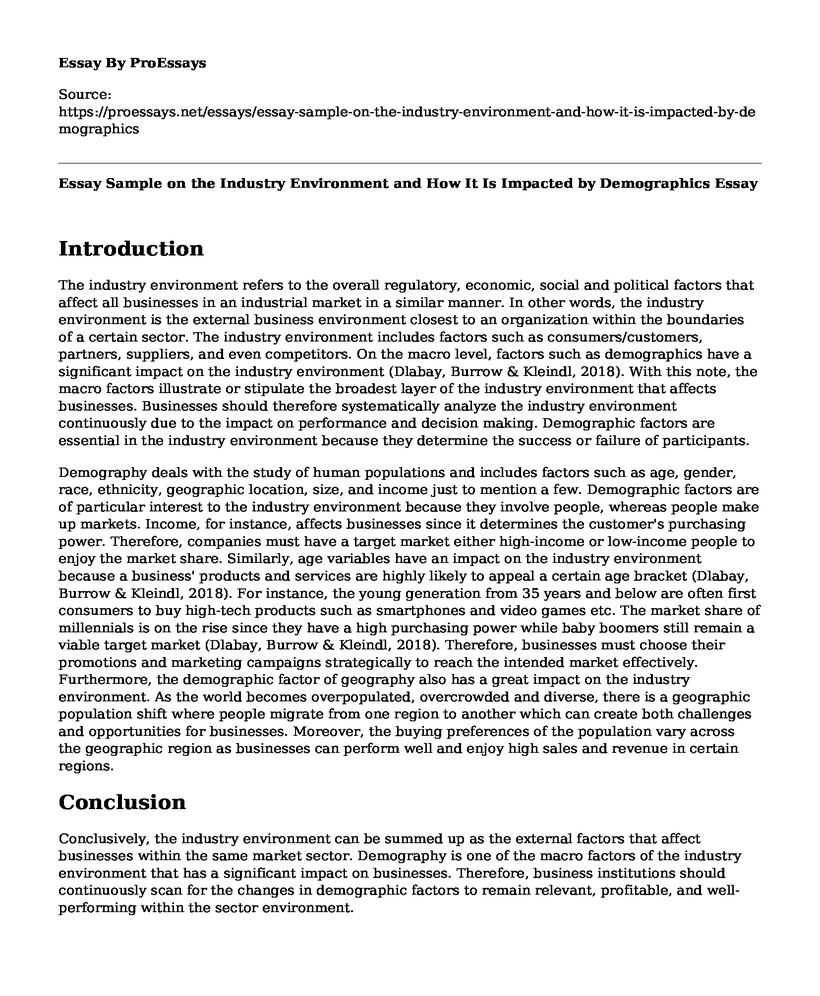Introduction
The industry environment refers to the overall regulatory, economic, social and political factors that affect all businesses in an industrial market in a similar manner. In other words, the industry environment is the external business environment closest to an organization within the boundaries of a certain sector. The industry environment includes factors such as consumers/customers, partners, suppliers, and even competitors. On the macro level, factors such as demographics have a significant impact on the industry environment (Dlabay, Burrow & Kleindl, 2018). With this note, the macro factors illustrate or stipulate the broadest layer of the industry environment that affects businesses. Businesses should therefore systematically analyze the industry environment continuously due to the impact on performance and decision making. Demographic factors are essential in the industry environment because they determine the success or failure of participants.
Demography deals with the study of human populations and includes factors such as age, gender, race, ethnicity, geographic location, size, and income just to mention a few. Demographic factors are of particular interest to the industry environment because they involve people, whereas people make up markets. Income, for instance, affects businesses since it determines the customer's purchasing power. Therefore, companies must have a target market either high-income or low-income people to enjoy the market share. Similarly, age variables have an impact on the industry environment because a business' products and services are highly likely to appeal a certain age bracket (Dlabay, Burrow & Kleindl, 2018). For instance, the young generation from 35 years and below are often first consumers to buy high-tech products such as smartphones and video games etc. The market share of millennials is on the rise since they have a high purchasing power while baby boomers still remain a viable target market (Dlabay, Burrow & Kleindl, 2018). Therefore, businesses must choose their promotions and marketing campaigns strategically to reach the intended market effectively. Furthermore, the demographic factor of geography also has a great impact on the industry environment. As the world becomes overpopulated, overcrowded and diverse, there is a geographic population shift where people migrate from one region to another which can create both challenges and opportunities for businesses. Moreover, the buying preferences of the population vary across the geographic region as businesses can perform well and enjoy high sales and revenue in certain regions.
Conclusion
Conclusively, the industry environment can be summed up as the external factors that affect businesses within the same market sector. Demography is one of the macro factors of the industry environment that has a significant impact on businesses. Therefore, business institutions should continuously scan for the changes in demographic factors to remain relevant, profitable, and well-performing within the sector environment.
Reference
Dlabay, L. R., Burrow, J., & Kleindl, B. (2018). Principles of Business. Mason: South-Western Educational Publishing.
Cite this page
Essay Sample on the Industry Environment and How It Is Impacted by Demographics. (2022, Nov 24). Retrieved from https://proessays.net/essays/essay-sample-on-the-industry-environment-and-how-it-is-impacted-by-demographics
If you are the original author of this essay and no longer wish to have it published on the ProEssays website, please click below to request its removal:
- Evaluation Essay on Intercontinental Hotel
- Essay Sample on Theory of Communication Competence
- Essay Sample on Computer Business Ethics
- What is Friendship?: Plato's Lysis Dialogue Explores Definitions - Essay Sample
- Paper Example on Mrs. Peters: A Subordinate of a Man in Susan Glaspell's Play
- Essay Example on August Wilson: American Playwright and Chronicler of African American Struggles
- Paper on Grandma and Me: Baking Our Way to Connection







